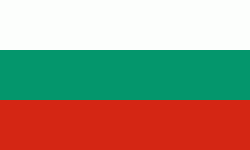Pazardzhik Province (Pazardzhik)
The territory of the Pazardzhik Province has been inhabited since very early times. There are more than 50 discovered Stone Age and Bronze Age settlements. The earliest civilization to inhabit the region were the Thracians. The remains of the Thracian town Besapara are located in the hills near the provincial capital Pazardzhik. The Panagyurishte Treasure unearthed near the northern town of the same name is known as one of the finest examples of Thracian art. The 6.164 kg of 23-karat gold treasure which consists of nine vessels has been dated back to the 4th and 3rd century BC. In the 1st century BC the region became a Roman province and remained in the Byzantine Empire after the fall of Rome.
Most of the region became part of the Bulgarian Empire in the beginning of the 9th century and remained in Bulgarian hands until the fall of the First Empire. With the rise of the Second Bulgarian Empire the region once again became part of the country until it was overran by the Ottomans in the late 14th century. Some of medieval fortresses are Tsepina near the village of Dorkovo and Krasen in the vicinities of Bata.
The April Uprising of 1876 against the Ottoman rule was widely supported within the region and the town of Panagyurishte became the center of the uprising. The Bulgarian population also rebelled to the south where the Ottoman atrocities culminated in the Batak massacre. The massacre included 8,000 people killed and one of the deadliest massacres in Bulgarian history. According to the Treaty of Berlin after the Liberation of Bulgaria in 1878 the region was included in the autonomous region Eastern Rumelia. It included the okolias Pazardzhik, Peshtera, Ihtiman, Koprivshtitsa and Panagyurishte. The department was later incooporated into the new Principality of Bulgaria on 6 September 1885.
The first reported Red Army troops in the region were in Pazardzhik on 23 September 1944, where the Soviet command was headed by Dimitry Gorunkov. Territorial changes were made, as Sarnitsa was transferred from Devinska okolia to Pazardzhik okolia in 1949. A concentration camp was established with the name Camp C. Demonstrations were held in 1989 with more than 5,000 people alone in the administrative capital.
Sarnitsa Municipality became the newest municipality in the province, as well as in Bulgaria on 1 January 2015.
Map - Pazardzhik Province (Pazardzhik)
Map
Country - Bulgaria
 |
 |
| Flag of Bulgaria | |
One of the earliest societies in the lands of modern-day Bulgaria was the Neolithic Karanovo culture, which dates back to 6,500 BC. In the 6th to 3rd century BC the region was a battleground for ancient Thracians, Persians, Celts and Macedonians; stability came when the Roman Empire conquered the region in AD 45. After the Roman state splintered, tribal invasions in the region resumed. Around the 6th century, these territories were settled by the early Slavs. The Bulgars, led by Asparuh, attacked from the lands of Old Great Bulgaria and permanently invaded the Balkans in the late 7th century. They established the First Bulgarian Empire, victoriously recognised by treaty in 681 AD by the Eastern Roman Empire. It dominated most of the Balkans and significantly influenced Slavic cultures by developing the Cyrillic script. The First Bulgarian Empire lasted until the early 11th century, when Byzantine emperor Basil II conquered and dismantled it. A successful Bulgarian revolt in 1185 established a Second Bulgarian Empire, which reached its apex under Ivan Asen II (1218–1241). After numerous exhausting wars and feudal strife, the empire disintegrated and in 1396 fell under Ottoman rule for nearly five centuries.
Currency / Language
| ISO | Currency | Symbol | Significant figures |
|---|---|---|---|
| BGN | Bulgarian lev | лв | 2 |
| ISO | Language |
|---|---|
| BG | Bulgarian language |
| TR | Turkish language |




















